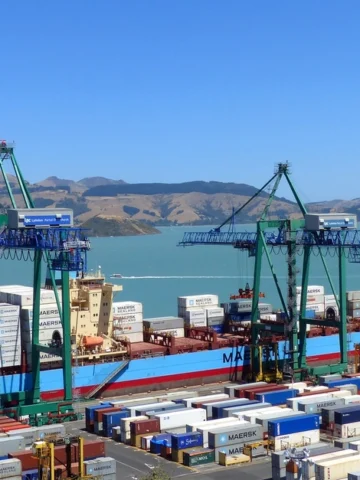In the world of supply chain logistics, transit time plays a crucial role in ensuring the smooth movement of goods from one location to another. The ability to accurately measure and manage transit times can have a significant impact on a company’s bottom line, customer satisfaction, and overall efficiency. In this guide, we will delve into the concept of understanding transit time, explore the factors that affect delivery times, discuss the importance of incorporating seasonality into transit time analysis, and highlight the benefits of implementing software solutions to monitor transit times and improve overall supply chain management effectiveness.

Measurement of Transit Time
Transit time is essentially the duration it takes for a product to travel from its point of origin to its intended destination. This metric is influenced by various factors, including the mode of transportation employed, the distance covered, and the size or weight of the goods being shipped. Accurate knowledge of transit times empowers logistics teams to plan effectively, anticipate potential delays, enhance customer service, and ensure that shipments arrive punctually and in optimal condition.
To gain a comprehensive understanding of transit time, it is crucial to analyze data and consider historical patterns. By leveraging data analysis and historical trends, businesses can estimate transit times more accurately, leading to better decision-making and improved supply chain management.
Factors That Affect Delivery Times
Several variables can impact the delivery time of a package or shipment. First and foremost, the type of freight being transported plays a significant role. Different products have different handling requirements, which can influence the choice of transportation mode and impact transit times accordingly.
The shipping mode itself is another crucial factor. Whether goods are transported via truck, rail, or air, each mode comes with its own advantages and limitations. For instance, air freight is typically faster but can be more expensive, while trucking offers greater flexibility for shorter distances but may be subject to road congestion and other logistical challenges.
External factors such as inclement weather conditions, holiday periods, and driver availability can also affect transit times. During adverse weather events, transportation networks may experience disruptions, leading to delays in deliveries. Similarly, peak holiday seasons often witness an upsurge in freight volumes, resulting in longer transit times.
Incorporating Seasonality Into Transit Time Analysis
Recognizing and accounting for seasonal fluctuations in transit times is vital for businesses operating in industries heavily influenced by holidays or high-traffic periods. For instance, during the holiday rush, businesses may face increased freight volumes and delays in air cargo transportation. By factoring in these seasonal variations, companies can provide their customers with accurate and realistic timelines for their shipments, thus ensuring proper expectation management.
By analyzing historical data and trends specific to holiday or high-traffic seasons, businesses can identify patterns and make informed decisions. This may involve adjusting production schedules, optimizing inventory levels, or exploring alternative transportation methods to mitigate potential delays.
Determining Capacity and Sizing for a Global Logistics Network
Building an efficient global logistics network requires careful consideration of various factors. Determining the appropriate capacity and sizing of the network is a critical step in ensuring smooth operations and timely deliveries.
Several elements need to be taken into account when assessing the required network capacity. Firstly, businesses must consider their specific business model, as different models have different demands and require varying degrees of network capacity. Secondly, the volume and types of freight being transported play a pivotal role in determining network size. High-volume industries may require larger networks to accommodate increased shipments, while specialized cargo may necessitate unique infrastructure or handling capabilities.
Delivery speed requirements are another essential consideration. Some businesses prioritize fast delivery times, necessitating a network with sufficient capacity to handle time-sensitive shipments. On the other hand, businesses with more flexible delivery windows can allocate resources differently, potentially reducing the required network size.
Lastly, credit terms and financial considerations can influence network sizing decisions. Companies that offer extended payment terms may need to factor in longer transit times to manage cash flow effectively.
Implementing Software Solutions to Monitor Transit Times and Overall Supply Chain Management Effectiveness
To optimize transit times and overall supply chain management, businesses can leverage advanced software solutions. These technologies provide valuable insights into various aspects of the supply chain, allowing for better monitoring and decision-making.
Software solutions can effectively track transit times, inventory levels, delivery accuracy, and supply chain visibility. By leveraging real-time data, businesses can identify potential bottlenecks, pinpoint areas for improvement, and make timely adjustments to enhance overall efficiency. Moreover, these software solutions facilitate effective communication and collaboration between different stakeholders in the supply chain, enabling seamless coordination and reducing delays.
One notable software solution is the Transportation Management System (TMS).
A TMS offers functionalities such as route optimization, carrier selection, and load planning. By automating these processes, companies can streamline transportation operations, reduce transit times, and improve overall supply chain performance.
Furthermore, implementing a Warehouse Management System (WMS) can enhance inventory management, order fulfillment, and warehouse efficiency. By optimizing inventory levels and streamlining order processing, businesses can minimize transit times and ensure on-time delivery.
Transit time is a crucial metric in supply chain logistics that significantly impacts customer satisfaction and business efficiency. By accurately measuring and managing transit times, businesses can optimize their operations, improve decision-making, and enhance overall supply chain management effectiveness.
Factors such as shipping mode, freight type, weather conditions, and seasonality all influence transit times. Understanding these factors and incorporating them into transit time analysis enables businesses to set realistic expectations and better plan for potential disruptions.
By leveraging software solutions, such as Transportation Management Systems (TMS) and Warehouse Management Systems (WMS), businesses can monitor transit times, inventory levels, and other critical metrics. These technologies provide valuable insights, facilitate data-driven decision-making, and enhance supply chain visibility, leading to improved transit times and overall operational efficiency.
In a rapidly evolving global marketplace, understanding and effectively managing transit times is essential for businesses seeking to thrive in the competitive landscape. By prioritizing transit time analysis, businesses can enhance customer satisfaction, build stronger relationships with partners, and ultimately drive success in their supply chain operations.
Check out our Blog for more logistics insioghts, tips and trends


